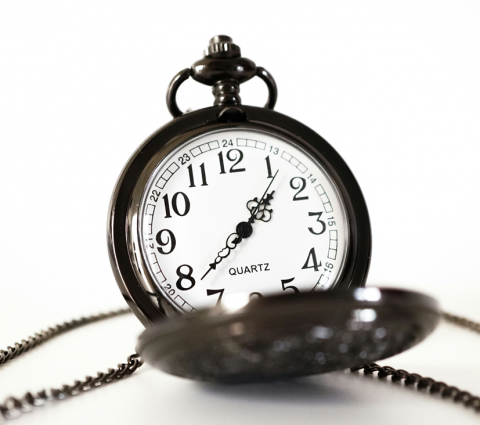Wonky watches
Mandeep's watch loses two minutes every hour. Adam's watch gains one minute every hour. Can you work out what time they arrived at the airport?
Problem
Mandeep's watch loses two minutes every hour.
Adam's watch gains one minute every hour.
They both set their watches from the radio at 6:00 a.m. then start their journeys to the airport. When they arrive (at the same time) their watches are $10$ minutes apart.

At what time (the real time) did they arrive at the airport?
Getting Started
What time will each watch say after an hour? Two hours ...?
How far apart will the times on the two watches be after an hour? Two hours ...?
Student Solutions
Jason from Priory Middle School, Dunstable says:
The time where the 2 watches are 10 mins apart is 9:20.
At 7 o'clock they're 3 mins apart
At 8 o'clock they're 6 mins apart
9 o'clock, 9 mins.
For 1 minute you divide 1 hour by 3, as 20 is 3 times as small as 60.
Then you add 9:00 and 0:20 to make 9:20, which is when they are 10 mins apart.
Stuart and Mark (Lower Juniors at Cummersdale, Cumbria) also say 9:20. They used this technique:
Every hour the difference between the two watches increases by 3 minutes 3x3=9
That gives us 3 hours and then divide 60 into 3 to make 20 minutes
3hours + 20mins = 3 20mins
6:00 a.m. + 3hrs 20 mins = 9:20 a.m.
George (Rosebank Primary School, Leeds) drew diagrams to show his thinking:
I knew that it would take them 3 hours and something because every hour they got three minutes apart. That meant that it will have minutes as well as hours. I knew that Mandeep's and Adam's watches went three minutes apart every hour. Now I needed to know how many minutes apart the boys' watches go in one minute. For this I drew a scale.

Then I marked how much they'd be apart.

This showed me that it must be between 15 and 30 minutes. When I divided it into even smaller parts I got the answer.

This got me to the answer, which is 3 hours and twenty minutes.
Daniel (Anglo-Chinese School - Primary, Singapore), Thomas (Tattingstone School) and Timothy (Munsang College, Hong Kong) gave very similar explanations. The one below is Timothy's:
Mandeep's watch loses 2 min every hour and Adam's watch gains 1 min every hour,
so they are 1 + 2 = 3 min apart after the 1st hour and 3 more mins after every hour.
When they arrive at the airport, their watches are 10 mins apart, so they travel:
10/3 hours = 60 x 10/3 = 200min = 3hours and 20mins
They start at 6:00am, so they arrive at 9:20am.
Tyler from Ysgol Dyffryn Dulas wrote:
Mandeep's watch has 58 mins per hour, I timesed that by 3 = 174
I did the same with 61, Adams' watch, 183
Now the difference was 9 mins
I timesed 58 by a third =19 and the same with 61=20
Now the difference was 1 minute
9+1=10 I had found the answer
174+19=193
183+20=203
Then I converted them to hours: 3:13, 3:23 from here I woked out as 7, the difference beetween 3:13 and 3:20 was 3, the difference beetween 3:20 and 3:23 was 7, which was roughly double 3.
3:20+6:00 was the answer to complete the soloution and that answer was 9:20 there for they arrived at 9:20.
Teachers' Resources
Why do this problem?
Possible approach
Key questions
Possible extension
Possible support

